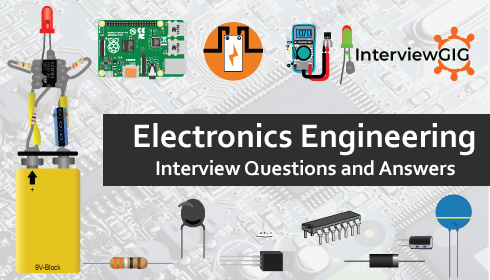Top 8085 Microprocessor Interview Questions and answers: Here, we highlight some common questions you might be asked during a job interview for Engineering related positions.
The 8085 microprocessor is an 8-bit microprocessor that was introduced by Intel in the mid-1970s. It became one of the most popular microprocessors of its time and played a crucial role in the development of early microcomputer systems.
Here’s a brief introduction:
- Architecture:
The 8085 microprocessor has an 8-bit data bus, meaning it processes data in 8-bit chunks.
It has a 16-bit address bus, allowing it to address up to 64 KB of memory.
The architecture includes various registers, such as the accumulator, general-purpose registers, and special-purpose registers like the program counter and stack pointer. - Clock Speed:
The 8085 typically operated at clock speeds ranging from 3 to 6 MHz. - Instruction Set:
The instruction set of the 8085 includes a variety of data manipulation, arithmetic, logic, and control transfer instructions.
It supports both direct and indirect addressing modes. - Registers:
The key registers in the 8085 include the accumulator (A), general-purpose registers (B, C, D, E, H, L), and special-purpose registers like the program counter (PC) and stack pointer (SP). - Interrupts:
The 8085 supports both maskable and non-maskable interrupts, allowing external devices to interrupt the normal program flow. - Peripheral Interfacing:
The 8085 microprocessor can interface with various peripheral devices, making it suitable for a wide range of applications. - Addressing Modes:
The addressing modes supported by the 8085 include immediate, direct, register, and indirect addressing modes, providing flexibility in programming. - Instruction Execution:
The execution of instructions in the 8085 follows a fetch-decode-execute cycle, where the microprocessor fetches an instruction from memory, decodes it, and then executes the corresponding operation. - Applications:
The 8085 microprocessor found applications in early personal computers, embedded systems, and educational environments.
Top 10 8085 Microprocessor Interview Questions and Answers (Advanced)
Question 1: What is the difference between CALL and PUSH instructions in the 8085 microprocessor.
Answer: CALL is a control transfer instruction that saves the return address on the stack and jumps to a subroutine, while PUSH is a data transfer instruction that pushes the specified register pair onto the stack.
Question 2: What is the purpose of the RIM (Read Interrupt Mask) instruction in the 8085 microprocessor?
Answer: RIM is used to read the status of interrupts and the state of certain flags. It reads the status of the interrupt lines and the status of the interrupt-enable flip-flops and loads the accumulator and other registers with this information.
Question 3: Can you explain the working of the DMA (Direct Memory Access) controller in conjunction with the 8085 microprocessor.
Answer: DMA is used to transfer blocks of data directly between memory and peripherals without involving the microprocessor. The 8085 microprocessor allows the DMA controller to take control of the system bus during data transfer, allowing faster and more efficient data movement.
Question 4: What is use of the SOD (Serial Output Data) pin in the 8085 microprocessor?
Answer: The SOD pin is used for serial data output. It allows the microprocessor to output serial data during serial communication. It is commonly used for communication with peripherals such as serially interfaced ADCs (Analog-to-Digital Converters).
Question 5: Differentiate between Maskable and Non-Maskable Interrupts in the context of the 8085 microprocessor.
Answer: Maskable interrupts can be enabled or disabled by the programmer using the SIM (Set Interrupt Mask) instruction, while Non-Maskable Interrupts (NMI) cannot be masked and always take priority over other interrupts.
Question 6: Explain the purpose of the TRAP interrupt in the 8085 microprocessor.
Answer: The TRAP interrupt is a non-maskable interrupt that is specifically designed for handling emergency conditions. It is often used for critical error conditions that require immediate attention.
Question 7: How does the 8085 microprocessor handle the HLT (Halt) instruction?
Answer: The HLT instruction stops the microprocessor’s clock, effectively putting it in a halt state. It remains in this state until a reset occurs or an interrupt is received.
Question 8: Describe the function of the SID (Serial Input Data) pin in the 8085 microprocessor.
Answer: The SID pin is used for serial data input. It allows the microprocessor to receive serial data during communication with peripherals.
Question 9: Explain the concept of pipelining in the 8085 microprocessor.
Answer: Pipelining is a technique where the microprocessor overlaps the execution of multiple instructions to improve throughput. In the context of the 8085, pipelining involves the simultaneous execution of fetch, decode, and execute stages for different instructions.
Question 10: Discuss the significance of the HOLD and HLDA signals in the 8085 microprocessor.
Answer: HOLD and HLDA signals are used in a system with multiple devices sharing the system bus. When a HOLD request is made, the microprocessor releases the bus control by asserting the HLDA signal. This allows another device to take control of the system bus temporarily. After the HOLD condition is released, the microprocessor regains control of the bus.
What is Microprocessor?
What are the various registers in 8085?
What are the different types of flags in 8085 microprocessor?
What is Stack Pointer?
Which Stack is used in 8085?
What is Program counter?
What is meant by a bus?
What are the types of buses?
What is Tri-state logic?
What are Hardware interrupts?
What are Software interrupts?
Which interrupt has the highest priority?
Name 5 different addressing modes?
How many interrupts are there in 8085?
What is clock frequency for 8085?
What is the RST for the TRAP?
What are input & output devices?
Why crystal is a preferred clock source?
What does Quality factor mean?
What are level-triggering interrupt?
How can signals be classified for the 8085 Microprocessor?
What are the various functional blocks of the 8085 Microprocessor?





